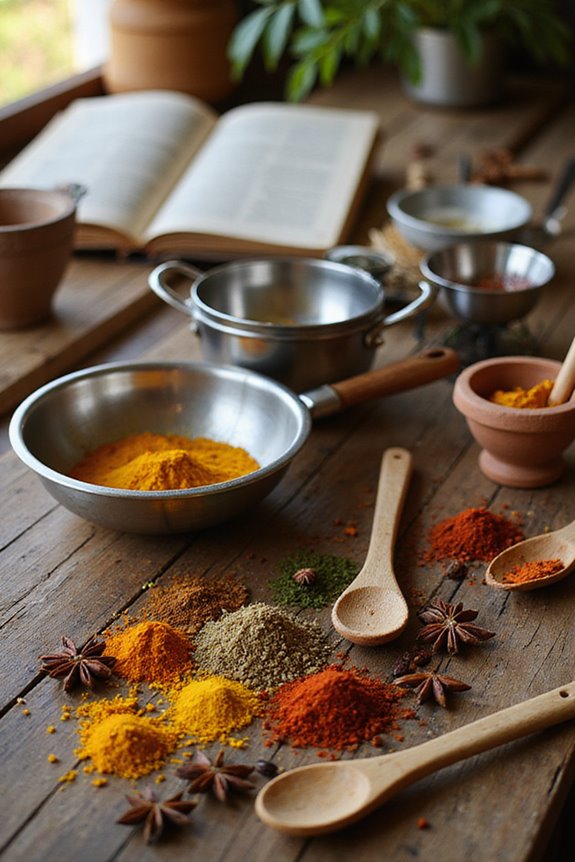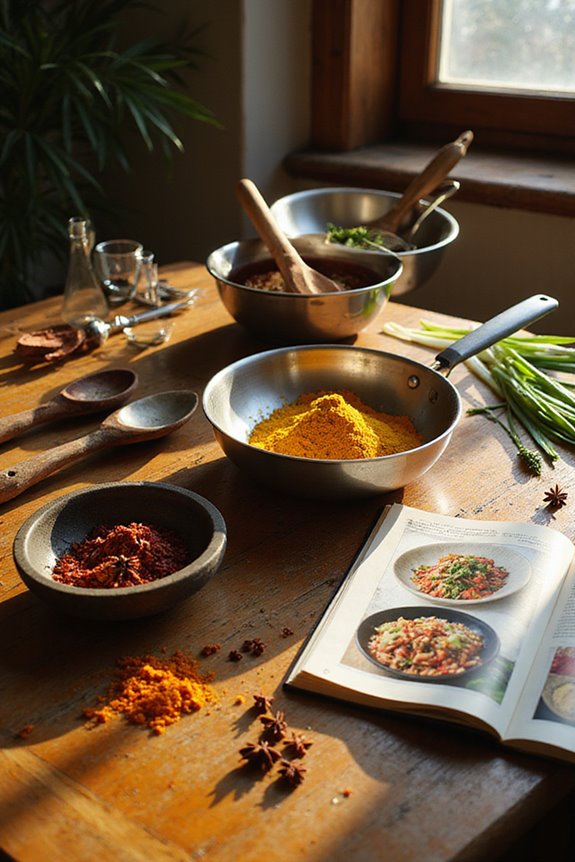To cook authentic Nepalese food, we’ll gather some delightful ingredients like red kidney beans, brown rice, and spices like garam masala and turmeric. Let’s master traditional techniques, such as tempering and slow cooking, which infuse our dishes with magical flavors! We can’t miss out on popular dishes like momos and dal bhat that warm the soul. So, roll up your sleeves and get ready to create a feast that will have everyone coming back for seconds, and don’t forget there’s more deliciousness to explore!
Key Takeaways
- Start with essential spices like Garam Masala and Turmeric to build authentic flavor profiles in your dishes.
- Utilize red kidney beans in hearty curries and opt for brown rice as a nutritious accompaniment.
- Master traditional techniques like tempering and slow cooking to enhance the aroma and taste of your meals.
- Experiment with popular dishes like Momos and Dal Bhat, ensuring to use local ingredients for authenticity.
- Explore Newari cuisine by trying dishes like Choila and Chatamari, emphasizing communal dining experiences.
Essential Ingredients for Nepalese Cuisine
When diving into the delightful world of Nepalese cuisine, having the right ingredients is like arming ourselves for a tasty adventure! Let’s explore essential components that make our taste buds dance.
Key Spice Blends:
- Garam Masala: Bursting with aromatic flavor.
- Turmeric: Adds a magical golden hue and health benefits.
Legumes and Grains:
- Red Kidney Beans: Perfect for hearty curries.
- Brown Rice: A healthier companion to our dishes.
Flavorful Oils:
– Mustard Oil: Infuses dishes with a nutty richness.
Additionally, including curry powders with various heat levels can elevate the depth of your dishes! Don’t forget to have plain yogurt on hand for that creamy finish! With these ingredients, we’re set to create tantalizing flavor profiles that warm the heart. Isn’t it time we cooked up some joyful memories together?
Traditional Cooking Techniques
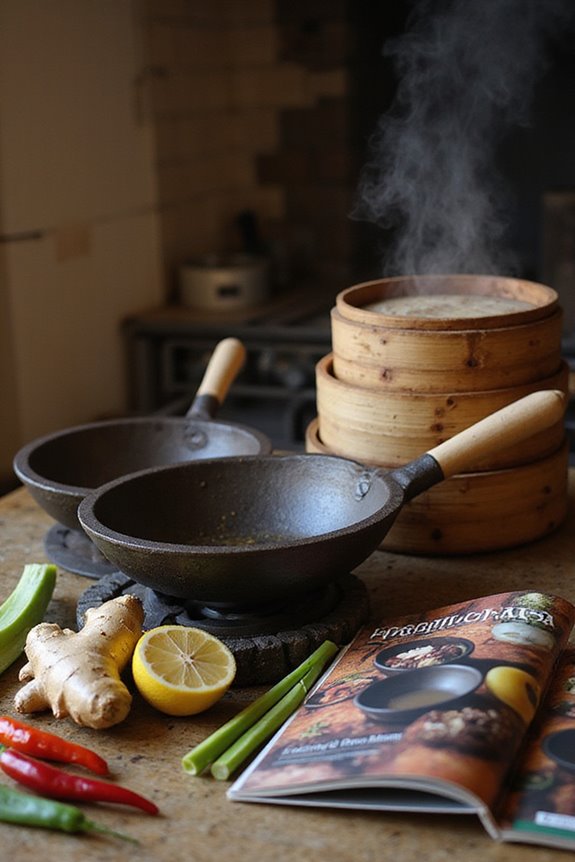
To begin our delightful culinary journey into traditional Nepalese cooking techniques, we’ll discover the magical methods that transform simple ingredients into mouth-watering dishes.
Tempering Techniques
- What Is It? This involves heating oil or ghee and adding spices like cumin and red chilies, releasing enticing flavors.
- Pro Tip: Pouring this flavorful tadka over dal at the end gives it a lovely aroma!
Slow Cooking Methods
- Why Slow Cook? Techniques like tarkari allow spices to blend beautifully with vegetables or meat.
- Final Thought: Simmering dishes not only enhances taste but results in tender, hearty meals—perfect for family gatherings! Additionally, experimenting with high smoke point oils can elevate the flavor profiles of your dishes significantly.
Ready to embrace these techniques? Let’s explore and make magical meals together!
Popular Nepalese Dishes to Try

Next up, we have Momoa—the beloved dumpling of Nepal. These little pockets of joy can be steamed, fried, or served in spicy gravy. Each bite bursts with flavor! Additionally, air frying options like Asian fish cakes can provide a nutritious twist to your meal.
Whether you’re digging into a warm Dal Bhat or savoring Momos with that zingy dipping sauce, we promise these dishes will make your taste buds dance. So grab your apron and let’s bring Nepal’s flavors to your kitchen!
Exploring Newari Cuisine
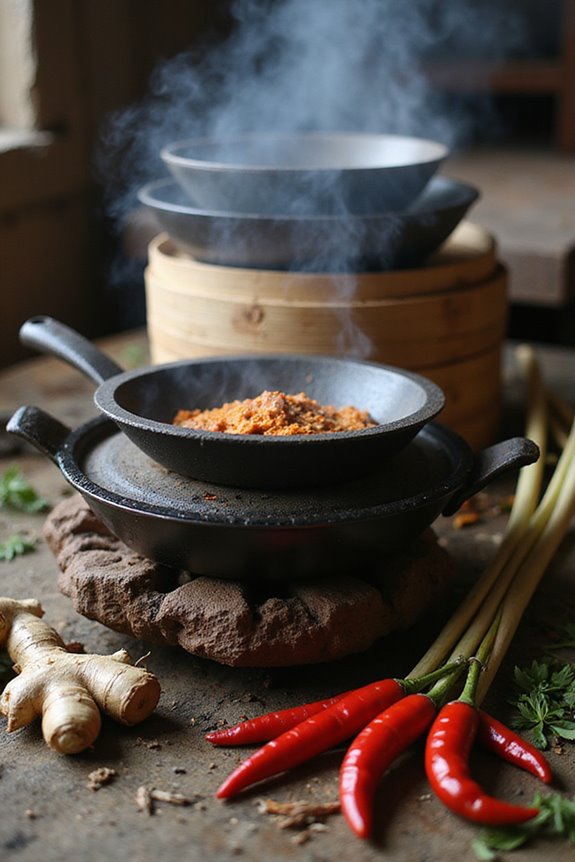
Exploring Newari cuisine is like setting out on a delightful culinary adventure right in our own kitchens! This rich food culture, celebrated during Newari festivals, offers a feast for our senses. Why not try some iconic dishes like:
- Choila: Spiced grilled buffalo meat, a festival staple!
- Chatamari: That’s right—Newari pizza topped with your favorite ingredients!
During Newari feasting, meals are often shared in a warm, communal spirit. We can recreate this by gathering friends and family. Incorporate traditional ingredients like taichin rice, lentil soup, and vibrant pickles. Using high-temperature cooking techniques, like grilling and steaming, enhances the authenticity of these dishes.
Street Food Favorites
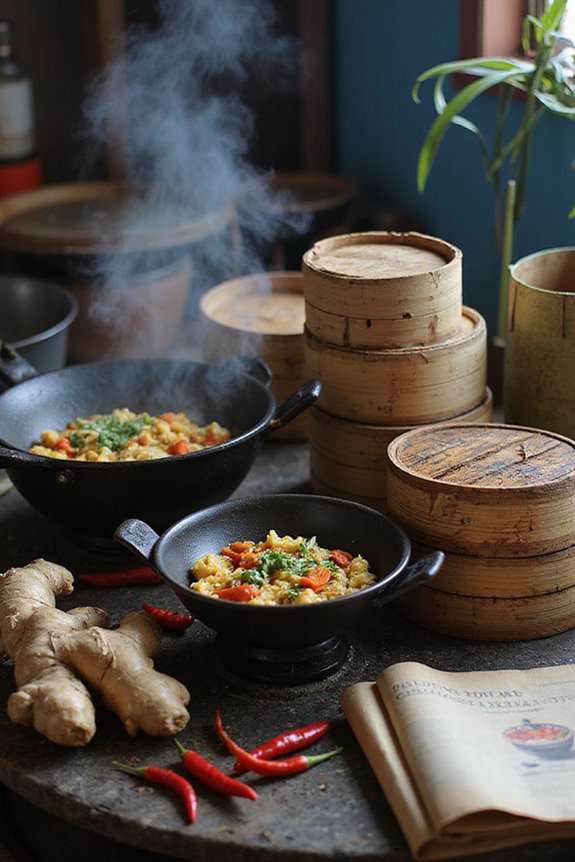
Street food in Nepal is a magical experience that we can savor right at home! Let’s explore our favorites:
- Momos: These delightful dumplings come in many variations — steamed, fried, or kothey. Fill them with seasoned meat or veggies for a burst of flavor!
- Sekuwa: For a smoky barbecue treat, try our sekuwa recipes! Marinate chicken or pork, then grill it over wood fire. It’s finger-licking good!
- Pani Puri: Don’t forget this crunchy delight! Fill the puris with spiced potatoes and a splash of flavored liquid for a fun snack. Vertical farming systems can even allow you to grow ingredients like leafy greens right at home!
Embrace these recipes, and you’ll feel like you’re enjoying the streets of Kathmandu right at home. Happy cooking — we can’t wait to taste your scrumptious creations!
Cultural Significance of Nepalese Meals
When we gather around the table to enjoy authentic Nepalese meals, we’re not just sharing delicious food; we’re also embracing a rich cultural heritage that brings people together. Communal dining plays a crucial role in unifying us, breaking down barriers of status and wealth. Each meal is infused with spiritual rituals, as we often begin by offering food to deities, making it feel even more special. This act promotes harmony among family and friends. Plus, the values of gratitude and generosity echo in every shared bite. Whether it’s a festive feast for Dashain or a cozy family dinner, we’re reminded that food connects us, fostering love and joy. So, let’s celebrate our heritage, one delightful meal at a time! Additionally, the significance of communal dining in Nepalese culture reflects our deep-rooted values and traditions that enhance the experience of sharing meals together.
Frequently Asked Questions
What Are the Best Rice Varieties for Cooking Nepalese Dishes?
When exploring the best rice varieties for Nepalese dishes, we’ve found Basmati’s benefits to be unparalleled, providing fluffy textures. Each variety adds its unique touch, inviting us to create comforting meals together that celebrate our shared culinary heritage.
How Can I Substitute Ingredients for Vegetarian Nepalese Recipes?
When we substitute ingredients in vegetarian Nepalese recipes, we can use vegetable alternatives like jackfruit and mushrooms while incorporating flavor enhancers such as spices and plant-based stocks to guarantee our meals remain deliciously authentic and satisfying.
What Kitchen Equipment Is Essential for Making Momos at Home?
What’s better than gathering with loved ones to make momos? We’ll need a momo steamer and a dough mixer to create the perfect batch, ensuring each bite’s filled with warmth and flavor. Let’s get started!
How Do I Know When Lentils Are Perfectly Cooked?
To know when lentils are perfectly cooked, we should check their textures and cooking times. They should feel soft, easily mashed, and have absorbed liquid. Let’s start tasting around the 20-minute mark for the best results!
What Are Common Beverage Pairings With Nepalese Meals?
When it comes to beverage pairings with Nepalese meals, we’ve got delightful tea traditions like Nepali tea and invigorating alcohol options like Raksi or Tongba. They truly enhance our shared dining experience and cultural connections.

